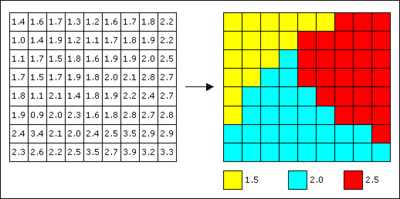GMS:Parameters: Difference between revisions
From XMS Wiki
Jump to navigationJump to search
| (9 intermediate revisions by one other user not shown) | |||
| Line 3: | Line 3: | ||
A parameter is a variable that is used to control one or more other values. GMS uses parameters with [[GMS:MODFLOW|MODFLOW]] to define inputs for [[GMS:Global_Options/Basic_Package#Run Options|forward runs]] or for [[GMS:Model_Calibration|model calibration]] or for [[GMS:Stochastic_Modeling|stochastic modeling]]. | A parameter is a variable that is used to control one or more other values. GMS uses parameters with [[GMS:MODFLOW|MODFLOW]] to define inputs for [[GMS:Global_Options/Basic_Package#Run Options|forward runs]] or for [[GMS:Model_Calibration|model calibration]] or for [[GMS:Stochastic_Modeling|stochastic modeling]]. | ||
==Key | ==Key Value and Standard MODFLOW Parameters== | ||
There are two ways to do MODFLOW parameterization in GMS: | There are two ways to do MODFLOW parameterization in GMS: | ||
*The [[GMS:Parameters#Key | *The [[GMS:Parameters#Key Values|key value method]] (recommended) | ||
*The [[GMS:Parameters#Standard MODFLOW | *The [[GMS:Parameters#Standard MODFLOW Parameters|standard MODFLOW method]] | ||
===Key | ===Key Values=== | ||
Key values are used to parameterize the MODFLOW input. Key values can be used for both the zonation and pilot points methods of defining parameters. A key value is a number that is assigned as input that marks the input values as belonging to a parameter. When selecting a key value, a number should be chosen that is not likely to occur in typical input for that parameter. | Key values are used to parameterize the MODFLOW input. Key values can be used for both the zonation and pilot points methods of defining parameters. A key value is a number that is assigned as input that marks the input values as belonging to a parameter. When selecting a key value, a number should be chosen that is not likely to occur in typical input for that parameter. In most cases, negative numbers are the best option. | ||
For example, a model may have four K zones and three recharge zones. The four K zones would be marked by assigning -100, -200, -300, and -400 to the cells in the ''K'' array for each of the four zones. Likewise, the recharge zones would be marked by assigning -500, -600, and -700 to the appropriate cells in the recharge array. | For example, a model may have four K zones and three recharge zones. The four K zones would be marked by assigning -100, -200, -300, and -400 to the cells in the ''K'' array for each of the four zones. Likewise, the recharge zones would be marked by assigning -500, -600, and -700 to the appropriate cells in the recharge array. | ||
| Line 19: | Line 19: | ||
The key value approach makes it much easier to support transient parameters and very large sets of pilot points. Also, this approach allows GMS users to use parameters with the BCF package. This feature is not available with the MODFLOW PES process. | The key value approach makes it much easier to support transient parameters and very large sets of pilot points. Also, this approach allows GMS users to use parameters with the BCF package. This feature is not available with the MODFLOW PES process. | ||
===Standard MODFLOW | ===Standard MODFLOW Parameters=== | ||
{{GMS:MODFLOW_Parameters_Disclaimer}} | {{GMS:MODFLOW_Parameters_Disclaimer}} | ||
For more information, refer to the [[GMS:Standard MODFLOW Parameters|Standard MODFLOW Parameters]] page. | For more information, refer to the [[GMS:Standard MODFLOW Parameters|Standard MODFLOW Parameters]] page. | ||
==Using | ==Using Parameters== | ||
To use parameters: | To use parameters: | ||
# [[GMS:Parameters#Parameterizing the | # [[GMS:Parameters#Parameterizing the Model|Parameterize the model]] and | ||
# [[GMS:Parameters#Create a | # [[GMS:Parameters#Create a Parameter List|Create a parameter list]] | ||
===Parameterizing the | ===Parameterizing the Model=== | ||
There are two methods used to parameterize a model: | There are two methods used to parameterize a model: | ||
*[[GMS:Parameters#Zonation|Zonation]] | *[[GMS:Parameters#Zonation|Zonation]] | ||
| Line 41: | Line 41: | ||
Zonation is most easily accomplished in GMS by assigning key values to polygons in the map module. It can also be accomplished by assigning key values to a selected set of cells in the 3D grid module using the [[GMS:Cell Properties|'''Cell Attributes''']] command. | Zonation is most easily accomplished in GMS by assigning key values to polygons in the map module. It can also be accomplished by assigning key values to a selected set of cells in the 3D grid module using the [[GMS:Cell Properties|'''Cell Attributes''']] command. | ||
==== Pilot | ==== Pilot Points ==== | ||
Another way to parameterize a model is to use pilot points. For more information on pilot points, refer to the [[GMS:Pilot_Points|Pilot Points]] page. | Another way to parameterize a model is to use pilot points. For more information on pilot points, refer to the [[GMS:Pilot_Points|Pilot Points]] page. | ||
===Creating a | ===Creating a Parameter List=== | ||
The list of parameters is defined using the [[GMS:Parameter_Dialog|''Parameter'' | The list of parameters is defined using the [[GMS:Parameter_Dialog|''Parameter'' dialog]]. In general, the number of parameters should be less than the number of observations. However, if the user chooses to use [[GMS:Pilot Points|pilot points]] with PEST in regularization mode, then the number of parameters does not have to be less than the number of observations. | ||
==== Legal MODFLOW | ==== Legal MODFLOW Parameters ==== | ||
The following MODFLOW input values can be defined as parameters in GMS: | The following MODFLOW input values can be defined as parameters in GMS: | ||
